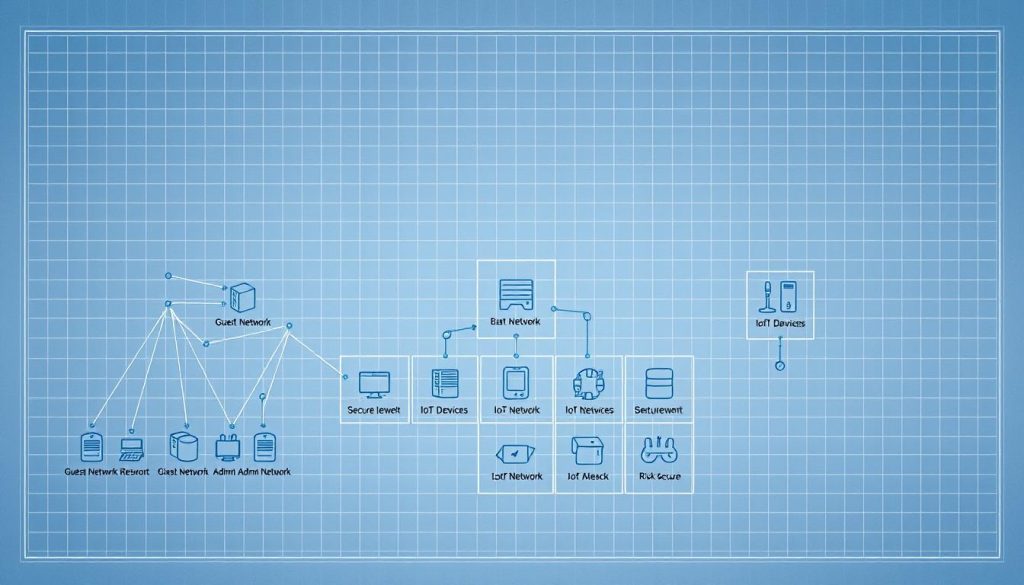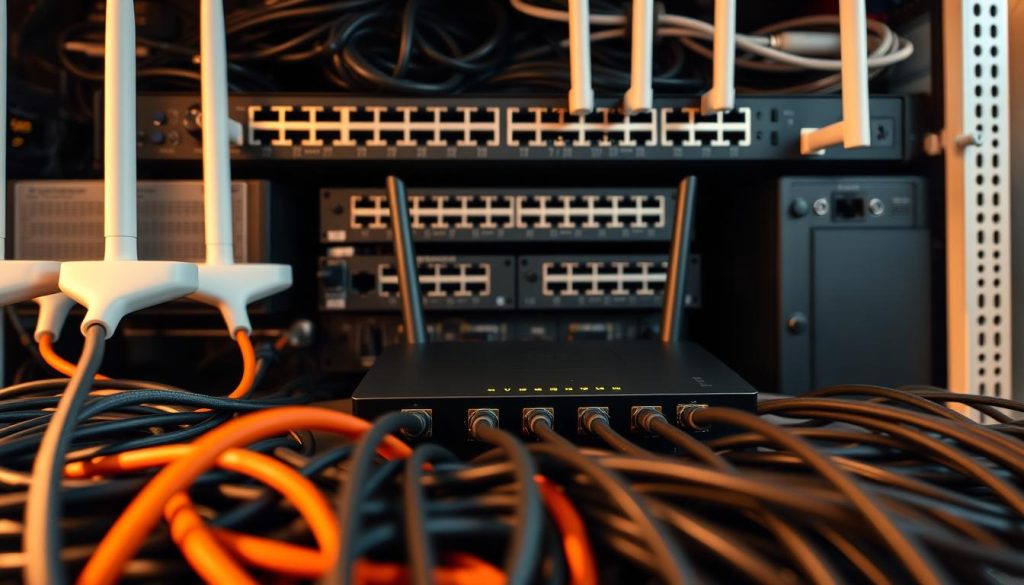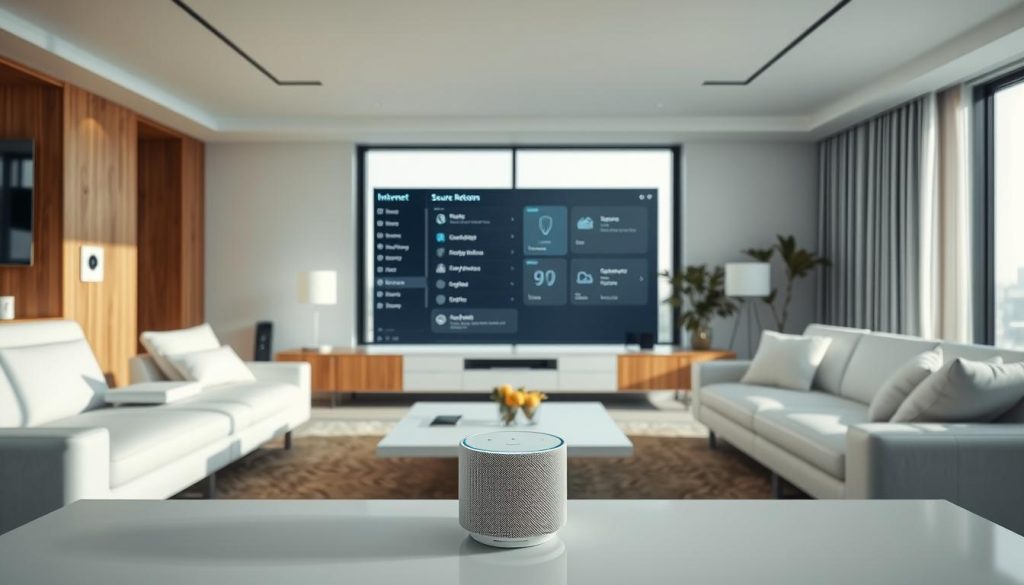Modern convenience brings new exposure. A typical home now has many smart home gadgets that join a single network. That growth makes the LAN noisy and raises the risk of an attacker moving between devices.
The solution is virtual separation. By creating VLANs and distinct subnets you reduce broadcast traffic and limit lateral access if one gadget is compromised. This method improves performance and makes troubleshooting easier.
It does not require swapping out all hardware. You need VLAN-capable routers, a managed switch, and a firewall that enforces policies. Real tools in use include OPNsense firewalls and EnGenius access points for segment-specific SSIDs.
This article will show a practical way to plan segments, build VLANs, assign SSIDs, enforce rules, and test them over time. Expect clear steps that scale from small apartments up to larger homes.
Key Takeaways
- Segmenting a network cuts broadcast noise and narrows attack paths.
- VLANs plus subnets contain threats and simplify troubleshooting.
- Compatible hardware and firewall policies are essential.
- Guest segments let visitors use the internet without local control.
- The approach scales and protects as the number of devices grows.
Why isolating smart home devices boosts home network security today
Separating traffic makes each gadget less useful as a foothold for an intruder.
Every new appliance, camera, or sensor that joins your home network is another potential entry point. Low-cost iot devices often ship with weak firmware support, telemetry that collects more data than needed, and irregular security updates.
That mixture of poor patching and hidden data flows raises the risk of remote compromise and enrollment in botnets. It also strains Wi‑Fi and DHCP services when many gadgets flood the LAN.
Segmentation gives those items internet access while blocking them from reaching your personal computers and phones. This limits the blast radius of any breach and helps protect privacy and sensitive data.
- Guest isolation keeps visitors online without exposing internal resources.
- Cameras, sensors, and connected appliances benefit most from being separated.
- Segmentation prevents lateral movement, so one compromised point won’t spread across the entire network.
What are VLANs, subnets, and network segmentation?
Logical segmentation creates distinct broadcast domains without adding new physical switches. This splits one physical infrastructure into separate groups so traffic stays within its lane.
VLAN basics: virtual separation on the same physical network
VLANs let you group ports and wireless SSIDs into isolated logical segments. Each group acts like its own LAN while sharing cables and switches. A common example pairs an IoT VLAN with 192.168.20.0/24 and a primary VLAN with 192.168.10.0/24.
Subnets explained: IP addressing that enforces logical boundaries
Subnets and DHCP scopes map addresses to segments. That makes routing predictable and keeps broadcast traffic limited. It also simplifies firewall rules that control which services may cross between segments.

Segmentation models: guest, IoT, cameras, and personal LANs
Typical models include a personal LAN, guest internet-only, an IoT group, and a camera zone with tighter limits.
- Managed switches plus VLAN-capable routers and access points with tagging are required.
- Inter-segment communication should happen only by explicit rules so a Home Assistant server reaches only approved devices.
- Think of each segment as a lane on a road with guardrails and controlled exits.
Plan your segmentation: map devices, risks, and access needs
Start by mapping every endpoint and its role so you know what each gadget actually does. A clear inventory makes later choices simple and fast.

Create an inventory: phones, PCs, IoT, sensors, and appliances
List phones, laptops, tablets, smart TVs, security cameras, sensors, and appliances. Note each item’s purpose and what sensitive data it handles.
Record network access needs such as internet-only, local service access, or integration with a controller like Home Assistant.
Risk-based grouping: cameras, streaming gear, and high-risk gadgets
Group high-risk gear away from personal computers and phones. Put security cameras and streaming boxes on stricter segments. Keep sensors and low-trust gadgets in their own lane.
- Inventory first: know every endpoint and its function.
- Classify by sensitivity: prioritize protection for data-rich systems.
- Upgrade hardware: use managed switches and a VLAN-capable router/firewall (OPNsense is a proven option).
- Define access rules: list which systems must communicate and which entries are blocked.
- Document entry points: map internet and internal service access to avoid accidental exposure.
- Allocate time: plan IP ranges and DHCP scopes to support growth and troubleshooting.
Using VLANs & Subnets to Isolate Smart Home Devices for Better Security
Start by picking hardware that supports traffic tagging and multiple SSIDs; this choice shapes the whole plan.
Pick a VLAN-capable router/firewall such as OPNsense and managed switches that support 802.1Q tagging. Set clear VLAN IDs and assign distinct subnets (for example, 192.168.10.0/24 for the LAN and 192.168.20.0/24 for IoT).
Configure DHCP scopes per subnet so addresses never collide. Map SSIDs on your access points to the correct VLAN so guests and less‑trusted devices land in the right lane.

Control traffic with precise rules and hardening
Apply default-deny firewall rules between segments. Allow only internet access from guest and IoT segments, and add narrow allow rules for exceptions—such as a Home Assistant controller reaching a camera at a single IP and port.
Finish by updating firmware, disabling unused services, and locking admin access with strong passwords and MFA. Document VLAN IDs, DHCP ranges, and the rule set so the network is easy to manage and scale.
| Component | Role | Example | Notes |
|---|---|---|---|
| Router/Firewall | Segment routing and rules | OPNsense | Supports VLAN routing and detailed firewall rules |
| Managed Switch | Tagging and port assignment | PoE switch with 802.1Q | Use access mode for wired controllers, trunk for uplinks |
| Access Points | SSID to VLAN mapping | Multi‑SSID AP | Broadcast IoT and guest SSIDs separately |
| Controller/NVR | Wired infrastructure | Home Assistant / NVR | Place on dedicated port with correct VLAN tag |
Test, monitor, and troubleshoot your segmented networks
Start verification by checking whether cross‑segment traffic is blocked from an ordinary client.
From a trusted laptop or wired test host, attempt pings and service connections across each lane. Confirm blocks unless a narrow allow rule exists in the firewall.
Run a port scan from your management lan to detect unintended open ports. That step finds accidental holes before an attacker does.
- DHCP checks: review scopes and client lists so every device landed on the intended vlan and subnet.
- Tagging issues: verify access points tag each SSID correctly; many iot devices fail if tags are missing.
- Rule validation: test allowed exceptions, then log and repeat tests after firmware updates.
Common fixes include correcting AP tagging, resolving overlapping DHCP scopes, and updating router and AP firmware when tag enforcement fails.
| Test | What it reveals | Action |
|---|---|---|
| Ping across segments | Isolation validation | Adjust firewall rules if ping succeeds unexpectedly |
| Port scan from management lan | Open services exposed | Close ports or add narrow allow rules |
| DHCP client list review | Misplaced clients or scope leaks | Fix scopes and bind interfaces correctly |
Pro tips to keep your smart home secure over time
A steady audit plan is the simplest way to keep your network resilient as gear ages. Regular checks stop small drift in rules and settings from becoming exploitable weaknesses.

Regular audits: rule reviews, device posture, and firmware updates
Set a schedule and stick to it. Quarterly reviews of firewall rules confirm least‑privilege access and remove stale entries.
Keep routers, switches, APs, and endpoints on a firmware cadence. Patch known vulnerabilities quickly to reduce the chance of breaches.
- Quarterly audits: verify firewall rules, DHCP scopes, and SSID mapping.
- Firmware discipline: apply updates on a set timeline and record versions.
- Guest handling: rotate guest network credentials and limit guest access to internet-only lanes.
- Clean up: delete unused SSIDs, remove old rules, and decommission test segments.
Advanced controls: IDS/IPS, MAC filtering, and logging for visibility
Enable logging and centralize events so you can spot anomalies fast. Consider IDS/IPS on your router firewall for active detection.
Use MAC filtering on sensitive segments and track hardware lifecycles so aging gear does not introduce new vulnerabilities.
- Detection: IDS/IPS helps catch unusual traffic before breaches escalate.
- Access limits: MAC filters add a layer of control for critical devices.
- Visibility: central logs support investigations and preserve privacy controls.
Make this way of maintenance part of household routine. Educate family members on safe onboarding so segmentation and privacy stay effective over time.
Conclusion
A clear plan cuts risk while keeping everyday convenience.
Split your home network by assigning per‑segment SSIDs and dedicated subnets, for example 192.168.10.0/24 and 192.168.20.0/24. Put guests, iot devices, and cameras on separate lanes and keep personal lan gear apart.
Enforce default‑deny firewall rules and add only narrow exceptions for required services. Use compatible routers, a managed switch, and correct SSID‑to‑vlan mapping. Validate isolation with ping and port‑scan checks and log results.
Keep firmware current, document ranges, and review rules on a schedule. Regular validation and minimal access changes sustain a resilient network that protects privacy, preserves functionality, and reduces the chance that a compromised camera or gadget exposes your data.

